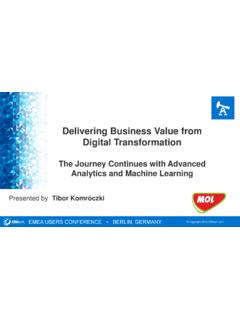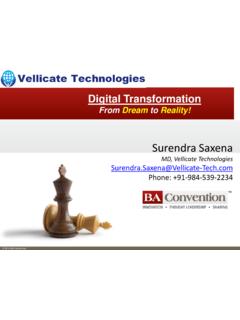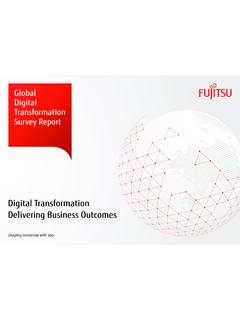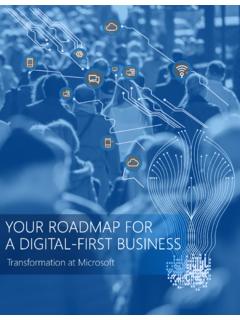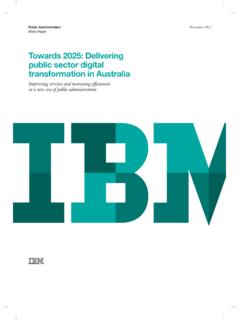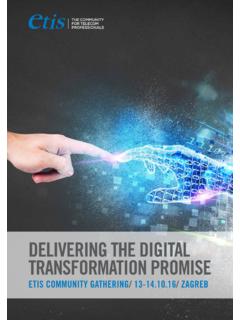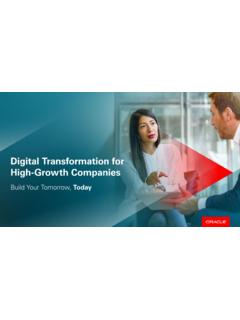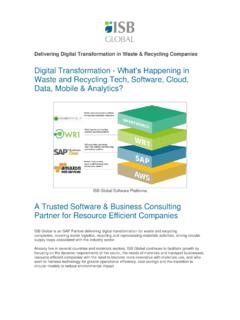Transcription of A REPORT BY HARVARD BUSINESS REVIEW ANALYTIC …
1 A REPORT BY HARVARD BUSINESS REVIEW ANALYTIC SERVICESD elivering on the Promise of digital TransformationSponsored byDELIVERING ON THE PROMISE OF digital transformation | 1 Copyright 2014 HARVARD BUSINESS School Publishing. All rights SHIFTS IN the ways that technology and information are consumed and delivered through cloud computing, big data, social networking, and smart devices are transforming how companies compete. Make no mistake, says Andrew McAfee, cofounder of the Initia-tive on the digital Economy at the MIT Sloan School of Management, this bundle of technol-ogy disrupters is the real thing. When fully deployed, these technologies will move most organizations to a new operating foundation, a move that McAfee says is comparable to the shift from steam power to elec-tricity 100 years ago. Once in a while there is a wave of technology that is such a big deal that transformation becomes the right word, he the early 1900s, many companies struggled to understand and financially justify invest-ments in electric power.
2 And few leaders of the steam-powered economy mastered the tran-sition. It s a pattern we see over and over when very powerful new technologies hit the BUSINESS world, says McAfee. If you don t navigate that wave properly, you re just in a huge amount of trouble. This time, IT is at the center of the fray, working with BUSINESS leaders to develop and exe-cute a digital transformation strategy that capitalizes on these major new technologies. A 2014 study of 537 IT and BUSINESS decision makers by HARVARD BUSINESS REVIEW ANALYTIC Services found that by adopting cloud, mobile, big data, and social media technologies together, companies were more likely to reap the transformational benefits of them all. figure 1 For a digital transformation strategy to succeed, though, technology executives must also transform their IT organizations to address the expectations of BUSINESS users and custom-ers for fast and easy access to IT services, according to Erik Dorr, senior research director with The Hackett Group.
3 In a recent REPORT , Reinventing IT to Support Sustainable, Innova-tion-Based Growth, Dorr and his colleagues write that IT has to redefine its value proposi-tion and revisit the way its success is monitored, measured, and reported. delivering on the Promise of digital TransformationHIGHLIGHTS35%of corporate spending on technology is outside IT70% of companies say data is driving BUSINESS transformation67%of CIOs expect to focus mainly on BUSINESS strategy within five years2 | A HARVARD BUSINESS REVIEW ANALYTIC SERVICES REPORTIn order to lead this transformation , IT executives must focus on three areas: collaborating with BUSINESS leaders to build a strategic vision, modernizing technology infrastructure, and rebuilding IT organiza-tions to execute against new digital BUSINESS Transformed BUSINESS Technology LandscapeEnd-user expectations of IT are high. Younger people entering the workforce these days find it ridiculous that the technologies they re asked to work with on Monday morning are in every important sense that they can perceive inferior to the ones that they were using on Sunday night, observes technology users are inside or outside the company, the customer experience shapes everyone s thinking, says Joe Topinka, CIO and vice president of multichannel commerce for Red Wing Shoes.
4 It means that IT has to be more converged with BUSINESS , integrated. and externally focused, because the customer experience can make or break your success. Internally, CIOs need to support users demands for easy and fast access to information and applications. If IT can t respond quickly enough, cloud computing makes it easy for BUSINESS users to go elsewhere for help. CIO magazine found in its 2014 State of the CIO survey that so-called shadow IT accounts for 35 percent of corporate IT 1 Adopting Multiple Technologies Increases transformation The greater number of technologies that companies indicated are critical to them, the more likely they were to REPORT each having a transformational effect on their overall HARVARD BUSINESS REVIEW ANALYTIC SERVICES SURVEY, MARCH 2014 ONE OF THE TECHNOLOGIES IS CRITICAL34%35%56%47%THREE TO FOUR OF THE TECHNOLOGIESARE CRITICAL80%67%81%75%TWO OF THE TECHNOLOGIESARE CRITICAL55%52%68%61% CLOUD SOCIAL MEDIA BIG DATA MOBILEDELIVERING ON THE PROMISE OF digital transformation | 3 Every year, the percentage [of IT funding]
5 That lives outside the CIO s budget increases, says Chris Curran, chief technologist and principal in the advisory practice at PwC, who has been asking companies for years about where the money for IT investments comes from. Meanwhile, IT executives must find a way to integrate new technologies with their existing infrastruc-tures, while at the same time increasing operational efficiencies and cutting costs. As Topinka suggests, companies that are succeeding at digital transformation know that it involves much more than IT. Leader-ship and a strategic approach to using IT across the enterprise are also critical. It s not just a matter of checking off a laundry list of innovative technologies, says The Hackett Group s Dorr. They are part of a bigger picture. How much an organization has internalized the importance of being tech-centric into the mind-set and culture translates into how companies think about solving prob-lems, committing resources, and creating opportunities.
6 In fact, McAfee and his colleagues found that having a plan for digital transformation was one of the hallmarks of leading-edge digital companies. Among the companies they studied for a forthcoming book, Leading digital : Turning Technology into BUSINESS transformation , so-called digital masters were distin-guished by how cleanly that vision was communicated and whether or not employees at all levels could articulate the strategy. (For more about McAfee s findings, listen to his HBR webinar, Leading digital transformation . IT s Enterprise VisionAlthough digital innovators lead with a vision, the CIO is integral to executing that vision. We have found that virtually none of the companies we call digital masters are doing it without including IT, says Didier Bonnet, senior vice president and head of global practices at Capgemini Consulting. Bonnet is a coauthor of Leading digital with McAfee and George Westerman, research scientist with the MIT Center for digital BUSINESS .)
7 IT is a fundamental component of the solution. Nowhere is the collaboration between IT and other BUSINESS leaders more important than when it comes to identifying and prioritizing digital projects. The CIO may not own the entire corporate IT budget, but he needs to own what PwC s Curran refers to as the enterprise view of IT, which covers both investment prioritization and IT architecture. Companies that don t treat digital as an enterprise capability run the risk of building new BUSINESS stovepipes, he high-level collaboration requires change by both the IT and line-of- BUSINESS sides of the house. Jeanne Ross, director and principal research scientist at the MIT Sloan School s Center for Information Systems Research, says that it s vital to map digital IT projects to strategic objectives and to have the dis-cipline to say no if someone s pet project doesn t measure up. It s really hard for companies to stay on target, she says.
8 They either haven t mapped the projects or they aren t committed to a limited set of strategic objectives. IT has to be proactively involved in strategic initiative development, says Red Wing Shoes Topinka. We have to get better at helping them realize that we are rowing the boat with them. The CIO magazine survey corroborates the heightened strategic profile of many CIOs. Sixty-seven percent say they will be focused mainly on strategic activities within the next three to five developed a framework that weighs any new investment ideas against six BUSINESS criteria: stra-tegic fit, operational fit, cost/benefit, risk, cost certainty, and whether it helps IT retire a system at the end of its life. Each proposal then receives a weighted score depending on how many of the criteria it benefits. Every investment uses that framework now, he says, not just technology expenditures. It came out of IT and now is used throughout the company.
9 4 | A HARVARD BUSINESS REVIEW ANALYTIC SERVICES REPORTT ransforming TechnologyWhile the conversation with BUSINESS users focuses on the BUSINESS value and the strategic contribution of new technology, CIOs must also take an architectural view of these new technologies as IT invest-ments by evaluating them in terms of how they affect the overall BUSINESS processes and technology infrastructure of the company. What will happen to existing BUSINESS processes when new technologies are deployed? How will new systems impact the functioning of existing systems? CIOs must consider important elements such as data flow, access, integration, and security as well as how they can find ways to make existing environments cost less and run more efficiently. While these operational elements of digital transformation may not be as sexy as developing cutting-edge mobile apps for customers, CIOs have to get them right.
10 Architecture is one of the key critical capabili-ties, but most non-IT people don t get it, says Ross. For example, if you have built a mobile self-service app for customers to check order status, you will likely need to pull data from a variety of systems, such as ERP and CRM databases, in order to provide customers with instant access to the information they need. If your back office is a mess of disconnected customer databases, you won t get far, says Bonnet. The biggest nightmare is how to get data to flow reasonably freely and integrate it in a form that makes sense to the BUSINESS community. Once again, BUSINESS input is required only this time, IT must help BUSINESS users understand technol-ogy requirements rather than vice versa. For example, Ross describes the way that Tetra Pak International SA, a $15 billion Swiss-based packaging and processing company, built a transformation group comprised of IT, strategic planning, and the global owners of seven major BUSINESS processes, including customer management, product creation, and supplier management.




